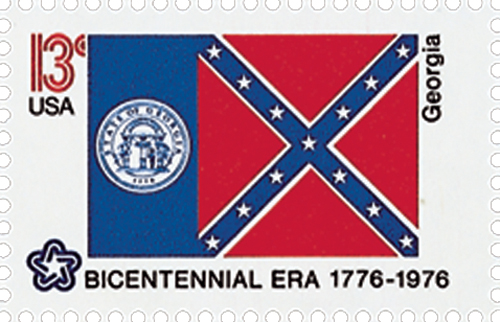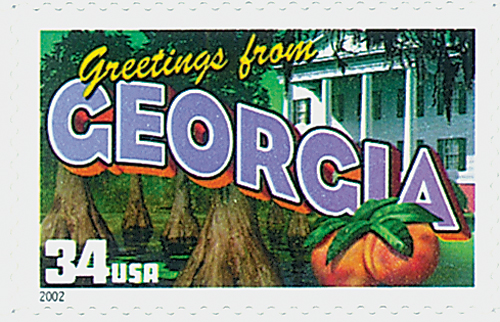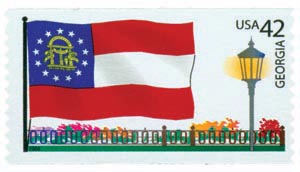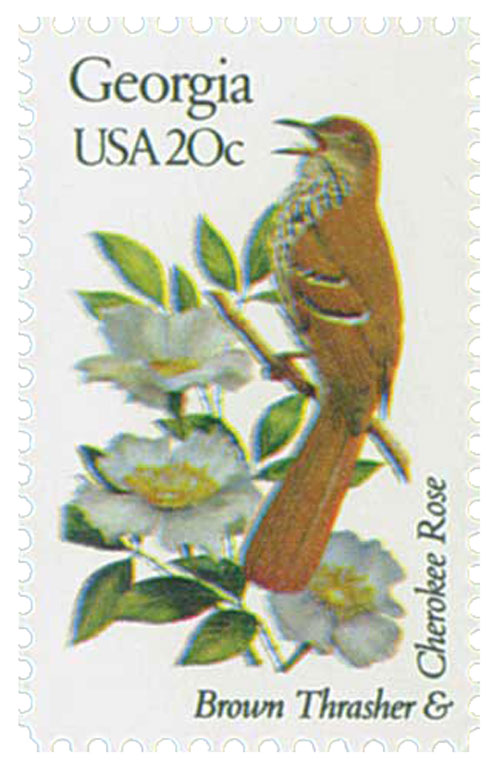
20¢ Georgia
State Birds and Flowers
City: Washington, DC and state capitals
Quantity: 13,339,000 panes
Printed By: Bureau of Engraving and Printing
Printing Method: Photogravure
Perforations: 10.5 x 11.25
Color: Multicolored
Georgia Becomes 4th State

On January 2, 1788, Georgia was the fourth state to ratify the US Constitution, making it our fourth state.
The first human inhabitants of Georgia were the Mound Builders, a prehistoric Native American tribe. Over time, the Creek tribe settled in the South and the Cherokee in the North.
The first European to explore was probably Hernando de Soto of Spain. He crossed the region on a trip from Florida to the Mississippi River in 1540. Spain, France, and England all claimed the southeastern portion of North America as part of their territory, but it was a group of Englishmen who planned the first colony there in 1730. They named it Georgia, in honor of King George II.

In 1732, King George granted a 21-year charter for the colony. The charter was granted to “Trustees for Establishing the Colony of Georgia in America.” Despite Spanish protests, on November 17, 1732, James Oglethorpe set sail from England with a group of 120 colonists. They arrived at Yamacraw Bluff on February 12, 1733. Today, the city of Savannah is located on that site. During the trustees’ 21-year control of the colony, 4,000 colonists arrived in Georgia.
The English used Georgia as a means of conducting illegal trade with Spain’s colonies in the West Indies. The two countries also disputed the proper boundary between Georgia and Florida. These conflicts led to the outbreak of war in 1739. Oglethorpe attempted to conquer Florida but failed. In 1742, Oglethorpe’s troops crushed a Spanish force landing at St. Simon’s Island, Georgia, in the Battle of Bloody Marsh. This victory ended the fighting in America, although the war continued in Europe.
King George made Georgia a royal province in 1754. Despite its prosperity, Georgia became involved in the movement for independence that was flourishing in other colonies. In 1775, when the Revolutionary War broke out in Massachusetts, support for independence solidified, and Georgia’s patriots seized power. Georgian forces first fought British troops in March 1776, when a British warship attempted to seize 11 rice boats in Savannah. Only two of the ships were captured. On July 24, 1778, Georgia ratified the Articles of Confederation.
In December 1778, the British captured Savannah. American forces, supported by the French Navy, attempted to liberate the city but failed. By the end of 1779, the British controlled the entire state except for Wilkes County. The British were finally driven from Georgia in 1782. The War for Independence ended in 1783.

On January 2, 1788, Georgia became the fourth state in the Union to ratify the United States Constitution. The state entered a period of rapid development in the 1790s as settlers and land companies began to spread into the region. In 1795, land companies used bribes to make large land purchases from the state. The land was purchased for about 1.5¢ an acre. The developers planned to re-sell the land at a huge profit. This scheme became known as the Yazoo Fraud. Angry Georgians elected a new legislature that repealed the earlier sales, but many of the land developers insisted their purchases were legal. In 1802, Georgia sold all of its land west of the Chattahoochee River to the US government. In 1814, the federal government finally paid $4,200,000 to settle the Yazoo claims.
The federal government also worked to remove all of the Native Americans from Georgia. In 1827, the Cherokee Indians sold the last of their lands to the US Federal troops forced the last remaining Cherokee Indians to move to reservation land in Oklahoma in 1838. Settlers quickly cleared the Indian land for farming, especially for growing cotton. By 1840, an extensive railroad system had developed through the state to transport people and agricultural products.

Georgia’s economy was based on cotton production, which depended heavily on slavery. On January 19, 1861, Georgia became the fifth state to secede from the Union. Early in the war, Union forces took control of the port of Savannah. Confederate troops won the first large battle in Georgia at Chickamauga in September 1863.
However, the war quickly turned against Georgia. Union troops, commanded by General William T. Sherman, captured the city of Atlanta in September 1863. In November, they burned the city and began the legendary “march to the sea.” Sherman’s forces marched toward Savannah, devastating everything they came across. As they cut a 60-mile-wide path through the state, destroying factories, mills, railroads, and other public buildings, they destroyed about $100 million in property. Largely unopposed, General Sherman captured Savannah in December 1864.

After the Civil War ended in 1865, Georgia continued to face hard times. Military rule lasted in the state on and off until 1870. Georgia was readmitted to the Union in 1868. But in 1869 it was expelled, due to its failure to ratify the 15th amendment, guaranteeing people of all races the right to vote. The amendment was ratified in 1870, and Georgia was permanently readmitted into the United States on July 15, 1870.
From the 1870s until the Great Depression (1929-1942), Georgia experienced economic growth. This period was marked by increases in manufacturing, trade, and banking, as well as railroad construction. With the start of World War II (1939-1945), Georgia’s economy resumed its industrial expansion. Large numbers of farmers and agricultural workers took factory jobs in the cities. The majority of these workers stayed in the cities after the war ended. By 1950, the United States census revealed that more Georgians worked in manufacturing than agriculture. In 1960, the census determined that the majority of Georgians lived in urban areas. The state continues to thrive economically. And like many states, it has been forced to deal with overcrowded cities, increased pollution, and racial tensions.

Georgia’s urban growth resulted in many political and social changes. Since the 1960s, the state’s legislative and congressional districts have been redivided several times. These modifications were made to give a more accurate representation of the population. In 1961, black children attended all-white schools for the first time. By August 1969, all of the state’s schools were ordered to be completely integrated.
Black leaders have also made progress in Georgia. In 1965, black civil-rights leader Julian Bond was elected to the Georgia legislature. Other legislators denied Bond his seat, but in 1966 the US Supreme Court ruled in Bond’s favor. In 1973, Maynard H. Jackson, Jr., was elected mayor of Atlanta, making him the first black mayor of a large Southern city.
20¢ Georgia
State Birds and Flowers
City: Washington, DC and state capitals
Quantity: 13,339,000 panes
Printed By: Bureau of Engraving and Printing
Printing Method: Photogravure
Perforations: 10.5 x 11.25
Color: Multicolored
Georgia Becomes 4th State

On January 2, 1788, Georgia was the fourth state to ratify the US Constitution, making it our fourth state.
The first human inhabitants of Georgia were the Mound Builders, a prehistoric Native American tribe. Over time, the Creek tribe settled in the South and the Cherokee in the North.
The first European to explore was probably Hernando de Soto of Spain. He crossed the region on a trip from Florida to the Mississippi River in 1540. Spain, France, and England all claimed the southeastern portion of North America as part of their territory, but it was a group of Englishmen who planned the first colony there in 1730. They named it Georgia, in honor of King George II.

In 1732, King George granted a 21-year charter for the colony. The charter was granted to “Trustees for Establishing the Colony of Georgia in America.” Despite Spanish protests, on November 17, 1732, James Oglethorpe set sail from England with a group of 120 colonists. They arrived at Yamacraw Bluff on February 12, 1733. Today, the city of Savannah is located on that site. During the trustees’ 21-year control of the colony, 4,000 colonists arrived in Georgia.
The English used Georgia as a means of conducting illegal trade with Spain’s colonies in the West Indies. The two countries also disputed the proper boundary between Georgia and Florida. These conflicts led to the outbreak of war in 1739. Oglethorpe attempted to conquer Florida but failed. In 1742, Oglethorpe’s troops crushed a Spanish force landing at St. Simon’s Island, Georgia, in the Battle of Bloody Marsh. This victory ended the fighting in America, although the war continued in Europe.
King George made Georgia a royal province in 1754. Despite its prosperity, Georgia became involved in the movement for independence that was flourishing in other colonies. In 1775, when the Revolutionary War broke out in Massachusetts, support for independence solidified, and Georgia’s patriots seized power. Georgian forces first fought British troops in March 1776, when a British warship attempted to seize 11 rice boats in Savannah. Only two of the ships were captured. On July 24, 1778, Georgia ratified the Articles of Confederation.
In December 1778, the British captured Savannah. American forces, supported by the French Navy, attempted to liberate the city but failed. By the end of 1779, the British controlled the entire state except for Wilkes County. The British were finally driven from Georgia in 1782. The War for Independence ended in 1783.

On January 2, 1788, Georgia became the fourth state in the Union to ratify the United States Constitution. The state entered a period of rapid development in the 1790s as settlers and land companies began to spread into the region. In 1795, land companies used bribes to make large land purchases from the state. The land was purchased for about 1.5¢ an acre. The developers planned to re-sell the land at a huge profit. This scheme became known as the Yazoo Fraud. Angry Georgians elected a new legislature that repealed the earlier sales, but many of the land developers insisted their purchases were legal. In 1802, Georgia sold all of its land west of the Chattahoochee River to the US government. In 1814, the federal government finally paid $4,200,000 to settle the Yazoo claims.
The federal government also worked to remove all of the Native Americans from Georgia. In 1827, the Cherokee Indians sold the last of their lands to the US Federal troops forced the last remaining Cherokee Indians to move to reservation land in Oklahoma in 1838. Settlers quickly cleared the Indian land for farming, especially for growing cotton. By 1840, an extensive railroad system had developed through the state to transport people and agricultural products.

Georgia’s economy was based on cotton production, which depended heavily on slavery. On January 19, 1861, Georgia became the fifth state to secede from the Union. Early in the war, Union forces took control of the port of Savannah. Confederate troops won the first large battle in Georgia at Chickamauga in September 1863.
However, the war quickly turned against Georgia. Union troops, commanded by General William T. Sherman, captured the city of Atlanta in September 1863. In November, they burned the city and began the legendary “march to the sea.” Sherman’s forces marched toward Savannah, devastating everything they came across. As they cut a 60-mile-wide path through the state, destroying factories, mills, railroads, and other public buildings, they destroyed about $100 million in property. Largely unopposed, General Sherman captured Savannah in December 1864.

After the Civil War ended in 1865, Georgia continued to face hard times. Military rule lasted in the state on and off until 1870. Georgia was readmitted to the Union in 1868. But in 1869 it was expelled, due to its failure to ratify the 15th amendment, guaranteeing people of all races the right to vote. The amendment was ratified in 1870, and Georgia was permanently readmitted into the United States on July 15, 1870.
From the 1870s until the Great Depression (1929-1942), Georgia experienced economic growth. This period was marked by increases in manufacturing, trade, and banking, as well as railroad construction. With the start of World War II (1939-1945), Georgia’s economy resumed its industrial expansion. Large numbers of farmers and agricultural workers took factory jobs in the cities. The majority of these workers stayed in the cities after the war ended. By 1950, the United States census revealed that more Georgians worked in manufacturing than agriculture. In 1960, the census determined that the majority of Georgians lived in urban areas. The state continues to thrive economically. And like many states, it has been forced to deal with overcrowded cities, increased pollution, and racial tensions.

Georgia’s urban growth resulted in many political and social changes. Since the 1960s, the state’s legislative and congressional districts have been redivided several times. These modifications were made to give a more accurate representation of the population. In 1961, black children attended all-white schools for the first time. By August 1969, all of the state’s schools were ordered to be completely integrated.
Black leaders have also made progress in Georgia. In 1965, black civil-rights leader Julian Bond was elected to the Georgia legislature. Other legislators denied Bond his seat, but in 1966 the US Supreme Court ruled in Bond’s favor. In 1973, Maynard H. Jackson, Jr., was elected mayor of Atlanta, making him the first black mayor of a large Southern city.















